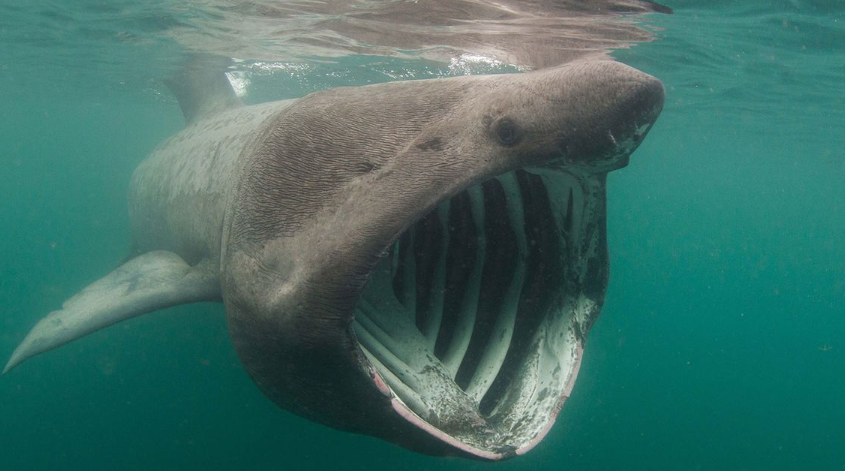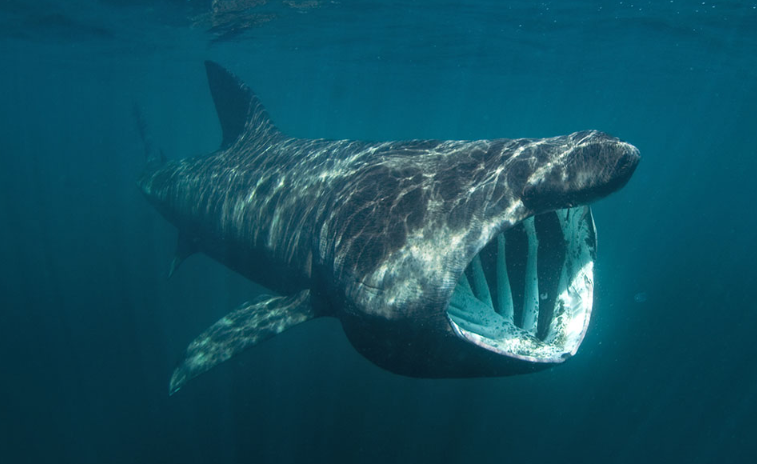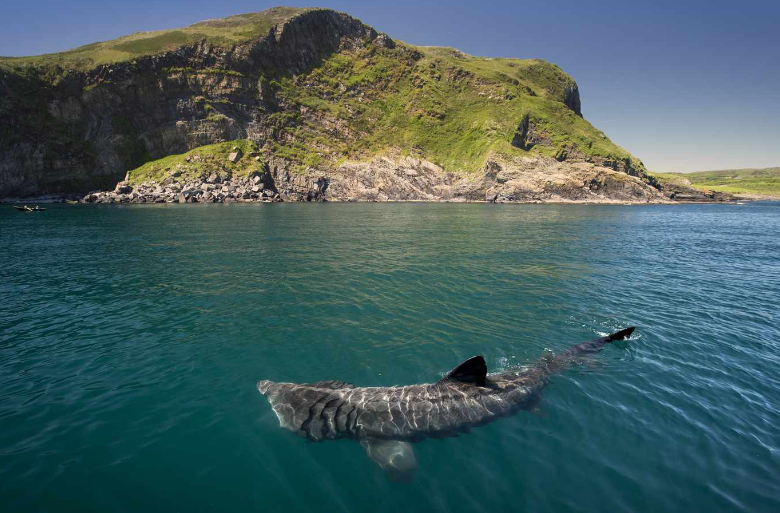Discover fascinating details about the basking shark – a magnificent creature that holds the title of the second largest fish currently existing. While sharks are commonly known as formidable predators of the sea, not all of them have a taste for meat. Rest assured, if you ever come across a basking shark, there’s no need to fear, as its primary focus lies in devouring plankton rather than humans!
Continue reading to delve into the captivating world of this extraordinary fish…
Basking Shark Facts At A Glance
Also known as the bone shark, elephant shark, hoe-mother, sail-fish, and sun-fish, the basking shark (Cetorhinus maximus) is a type of cartilaginous fish. It belongs to the animal family Cetorhinidae and is found in cool and temperate oceans around the world. Measuring between 6 to 8 meters (20 to 26 feet) in length and weighing around 2 metric tons (5.1 long tons; 5.7 short tons), this remarkable creature possesses a jaw width of up to 1 meter (3.3 feet). The basking shark is classified as vulnerable in terms of conservation status. One fascinating fact about the basking shark is that its liver can account for as much as 25% of its total body weight.
Meet The Basking Shark: Introduction

The basking shark holds the title of the second-largest fish on Earth, surpassed only by the enormous whale shark. The biggest documented basking shark reached a length of 12.27 meters (40.3 feet) but there have been reports of even larger individuals, although they lack verification.
Out of all the sharks that rely on plankton as their main food source, the basking shark is one of the three known species. The other two are the aforementioned whale shark and the rarely sighted megamouth shark.
In contrast to their more predatory relatives, plankton-eating sharks sustain themselves by consuming tiny floating food particles instead of pursuing larger prey.
Belonging to the order Lamniformes, which is also known as the mackerel sharks, the basking shark stands as the sole representative of the Cetorhinidae family.
What Does The Basking Shark Look Like?
Experience the awe-inspiring visuals in the video provided, showcasing captivating close-up imagery of the Earth’s runner-up in terms of size among aquatic creatures, the second largest fish on our planet…
The basking shark stands out with its massive size, gigantic mouth, small eyes, and prominent nose (indicated by the ‘rhinus’ in its scientific name).
Its pectoral fins on the sides can reach lengths of up to 2 meters (6.6 feet). The large dorsal fin often bends to one side when the shark surfaces, while the tail fin takes on a crescent shape.
The basking shark’s distinct gill slits almost completely encircle its cone-shaped head. Its teeth are curved and arranged in multiple rows on both the upper and lower jaws. These teeth are believed to be unused due to the shark’s filter feeding behavior.
The coloration of the basking shark varies. Typically, it has a gray-brown hue with pale white undersides and occasional lighter patches. The skin has a rough texture and is covered in mucus.
Many individuals bear noticeable scars, likely a result of encounters with parasitic or predatory fish.
Distribution: Where Is The Basking Shark Found?

The basking shark is a magnificent creature that can be found in oceans with cool and temperate climates across the globe. In the Northern Hemisphere, these sharks inhabit the northern regions of the Atlantic and Pacific Oceans. Their population extends as far south as Florida in the United States, Senegal in Africa, and the coast of China.
In the Southern Hemisphere, basking sharks can be spotted in the Pacific Ocean, ranging from the waters surrounding Australia and New Zealand to the South American coast below Colombia. In the Atlantic Ocean, they can be found from the South American coast south of Brazil to the African coast south of Angola.
Habitat
In the seasons of spring and summer, the basking shark can typically be spotted gliding near the surface of coastal waters, and occasionally even in brackish areas where fresh and salt water mix, like estuaries.
When winter arrives, basking sharks tend to migrate towards deeper waters. There have been instances where they have been observed swimming at remarkable depths reaching up to 910 meters (2,990 feet).
Based on numerous observations, it seems that the basking shark favors water temperatures ranging from 8 to 14°C (46.4 to 58.1 °F). However, in certain regions such as New England, USA, this species has been documented in much warmer waters reaching temperatures of up to 24°C (75 °F).
Basking Shark Behavior

The basking shark is often found alone, but occasionally it can be spotted in pairs, small groups, or even gatherings of up to 100 individuals when there is an abundance of food. Throughout the year, this species embarks on extensive migrations to find areas with the highest concentrations of food. It was once believed that the basking shark hibernated during winter, but that is not the case.
This shark earned its name because it tends to feed near the water’s surface at slow speeds, creating the illusion that it is leisurely “basking” in the water. While feeding, the shark typically moves at a speed of approximately 3.7 km (2.3 miles) per hour.
Although the basking shark is usually slow-moving, it has the ability to leap completely out of the water. The exact reason behind this behavior remains unclear, but potential explanations include efforts to remove parasites or displays of strength.
Breeding
During the early summer, the basking shark engages in mating rituals within coastal waters. Similar to other mackerel sharks, this species is believed to possess an ovoviviparous reproductive system. Ovoviviparity entails the hatching of eggs inside the female’s uterus prior to giving birth.
Curiously, only the right ovary of the female basking shark appears to be functional, and the reason behind this remains unknown.
It is speculated that pregnant females venture into deeper waters. The gestation period can last anywhere from 1 to 3 years, allowing each female the potential to give birth to a new litter every 2 to 4 years.
To date, only one pregnant female basking shark has ever been captured, and she was carrying 6 offspring. The length of newborn juveniles is estimated to range between 1.5 and 2 meters (4.9 and 6.6 feet).
What Do Basking Sharks Eat?
The basking shark is a unique filter feeder that relies on a passive feeding method. It primarily feeds on zooplankton, particularly copepods, which are small crustaceans belonging to the Calanoida order. Additionally, small fish and fish eggs are also included in its diet.
What sets the basking shark apart from other filter-feeding sharks is its feeding technique. Instead of actively pumping water into its mouth, the basking shark swims slowly through the water with its wide-open mouth, allowing water to flow in and out naturally. As water enters the mouth and exits through the gills, the shark’s mouth features gill rakers, which are thin, bristle-like projections. These gill rakers effectively capture the food particles present in the water as it passes out through the shark’s gills.
Is The Basking Shark Dangerous To Humans?
The basking shark is often hailed as a magnificent creature of great size and intimidating countenance. However, beneath its colossal frame and fearsome visage lies a gentle nature that poses no threat to us humans.
Is The Basking Shark Endangered?
The basking shark is currently classified as “Vulnerable” by the International Union for Conservation of Nature (IUCN).
Evidence indicates that the basking shark population has been experiencing a significant decline, potentially by as much as 80% since the 1950s. Populations in the North Pacific and Northeast Atlantic regions are specifically at risk and considered endangered. This species is particularly susceptible to overexploitation due to its slow reproductive rate and lengthy maturation period.
The primary factors contributing to the decline in basking shark numbers are as follows:
- Overexploitation: The basking shark has long been of great commercial importance, with various industries utilizing its skin, flesh, cartilage, and liver. It is especially targeted for its large fins, which command high prices in the international shark fin trade.
- By-catch: Basking sharks are frequently unintentionally caught in trawl nets that are primarily intended for capturing other species.